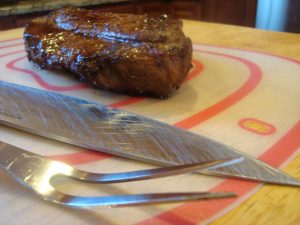 You may have wondered what London Broil really is. It’s not really a special cut of beef or from a particular part of the cow. It’s actually a STYLE of cooking or grilling a piece of beef. Typically London Broil is Flank steak but not necessarily.
You may have wondered what London Broil really is. It’s not really a special cut of beef or from a particular part of the cow. It’s actually a STYLE of cooking or grilling a piece of beef. Typically London Broil is Flank steak but not necessarily.
Many times (like in the above London Broil video) the supermarket will use or label a top round steak/roast as London Broil.
So Just What Is A London Broil?
In North America London Broil is basically an affordable cut of beef – marinated – grilled and sliced thin.
In Canada London Broil is thought of as a ground meat patty wrapped in flank or round steak is known as a London broil.
Ironically, the dish is unknown in the English city of London.
In general the meat will be a tough cut, but generally affordable.
You can go from tough to tender by following a few general tricks and tips for the BBQ.
First pound it with a meat mallet. In a way – not to be gross – it’s almost pre-chewing it. Break up the tough fibers a bit. Don’t worry about the meat looking mashed. In the end your BBQ will still look pristine. If it’s a larger cut just hit it harder! Good stress relief. Tip: wrap the meat in plastic wrap to avoid splatters.
Next, use a marinade like this Steak Marinade to soften the newly damaged fibers. Any high acid marinade will aid the tenderizing effects.
Then use what’s called the reverse sear – cook it slow to an internal temp of about 120 — then pull it off until the the center just starts to lower and finish the cook with a fast sear direct over red hot heat.
Finally, let the cooked meat rest for five to ten minutes or so before slicing AGAINST the grain of the meat fibers or perpendicular to the strands of beef in pencil thin slices.
For more on tenderizing check out 3 Tips For Tenderizing HERE.

